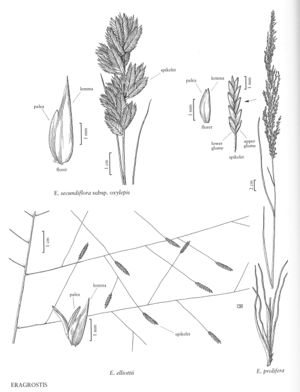Eragrostis elliottii
Plants perennial; cespitose, with innovations, without rhizomes, not glandular. Culms 25-80 cm, erect, glabrous and shiny below the basal nodes. Sheaths sparsely hairy at the apices, hairs to 6 mm; ligules 0.2-0.4 mm; blades 6-30 (52) cm long, 2-4.5 mm wide, flat, abaxial surfaces glabrous, adaxial surfaces scabridulous, some¬times with a few scattered hairs near the base. Panicles (25) 30-60 cm long, 15—45 cm wide, broadly ovate to obovate, open, diffuse; primary branches mostly 5-25 (32) cm, diverging 20-90° from the rachises, capillary; pulvini hairy; pedicels (4) 10-35 (50) mm, widely diverging, capillary, all the pedicels on each branch longer than the spikelets. Spikelets 4-18 mm long, 1.4-3 mm wide, linear-lanceolate, grayish-green or stramineous to purplish, with (6) 9-30 florets; disarticulation acropetal, below the lemmas, paleas persistent. Glumes narrowly lanceolate, membranous; lower glumes 1.1-3.4 mm; upper glumes 1.6-3.4 mm, apices acuminate; lemmas 1.8-4.4 mm, lanceolate, membranous, lateral-veins evident to inconspicuous, sometimes greenish, apices acute to acuminate; paleas 1.1-3.5 mm, hyaline to membranous, narrower than the lemmas, apices obtuse; anthers 2, 0.3-0.8 mm, purplish or brownish. Caryopses 0.6-0.8 mm, ovoid to ellipsoid, finely striate, reddish-brown. 2n = unknown.
Distribution
Puerto Rico, Virgin Islands, Okla., Miss., Tex., La., Ark., Mo., Ala., Fla., Ga., N.C., S.C.
Discussion
Eragrostis elliottii grows in sandy pinelands and live-oak woodlands on the coastal plain, at 0-150 m. Its range extends from the southeastern United States through the West Indies and Gulf coast of Mexico to Central and South America.
Selected References
None.
Lower Taxa
"decumbent" is not a number.
